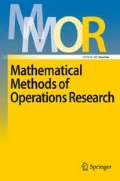Summary
Output learning is incorporated into a short-run static cost-minimizing model of the multiproduct, multifactor firm which employs a fixed-coefficients technology. The firm's output processes or activities are ultimately specified as functions of the activity variables themselves, thus rentering a generalization to a concave program. A Lagrange dual formulation is then used to obtain the indirect cost objective. Given that this optimal cost function is differentiable and satisfies a regularity condition, its price derivatives serve as input demand functions while its derivatives with respect to the minimum output requirements yield a set of (implicit) marginal costs or dual variables.
Similar content being viewed by others
References
Baumol W (1977) Economic Theory and Operations Analysis, 4th ed. Prentice-Hall Inc., New Jersey.
Boulding K, Spivey W (eds.) (1966) Linear Programming and the Theory of the Firm. Macmillan & Co., New York.
Chen J (1983) Modeling Learning Curve and Learning Complementarity for Resource Allocation and Production Scheduling. Decision Sciences 14:170–186.
Diewert W (1971) An Application of the Shephard Duality Theorem: A Generalized Leontief Production Function, Journal of Political Economy, 1971, 79, 481–507.
Geoffrion A (1971) Duality in Nonlinear Programming: A Simplified Application Oriented Development. SIAM Review 13: 1–37.
Liao W (1979) Effects of Learning on Resource Allocation Decisions. Decision Sciences 10: 116–125.
Naylor T (1965) Kuhn-Tucker Model of the Multi-Product, Multi-Factor Firm. Southern Economic Journal 31: 324–330.
Reeves G (1980) A Note on the Effects of Learning on Resource Allocation Decision. Decision Sciences 11:169–170.
Reeves G, Sweigart J (1981) Product-Mix Models When Learning Effects are Present. Management Science, 1981, 27: 204–212.
Shephard R (1953) Cost and Production Functions. Princeton University Press, Princeton New Jersey.
Author information
Authors and Affiliations
Rights and permissions
About this article
Cite this article
Panik, M.J. Output learning and duality in joint production programs. ZOR - Methods and Models of Operations Research 34, 463–467 (1990). https://doi.org/10.1007/BF01421553
Received:
Issue Date:
DOI: https://doi.org/10.1007/BF01421553




